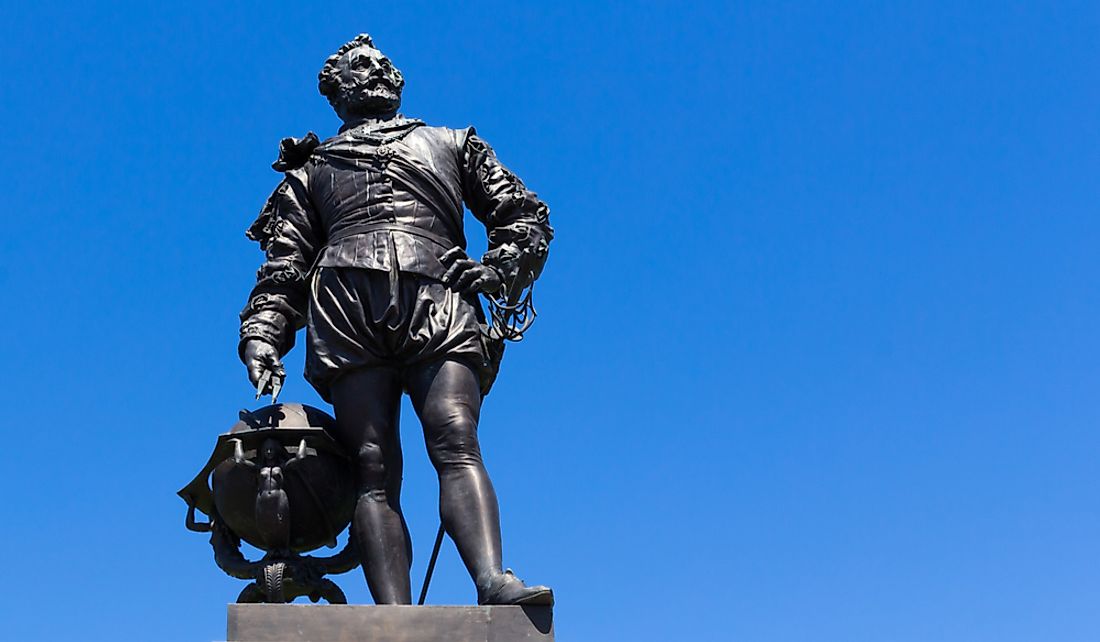Sir Francis Drake - Famous Explorers of the World

Sir Francis Drake is a notable English sea captain and explorer. He is famously remembered for being the second person to circumnavigate the world in a single expedition and the first captain to complete the journey. Drake is credited with discovering Elizabeth Island off the tip of South America. He also claimed land in what is now the state of California for the British Crown. The Drake Passage was named for him, although it now seems unlikely that he reached it. Queen Elizabeth rewarded his world exploration with a knighthood in 1581.
5. Early Life
Francis Drake was born on July 13, 1540. His birthplace was in Tavistock, Devon, England, and he belonged to a Protestant family. His father was a farmer who turned into a deacon, and later even became a vicar. As a young boy, Drake was apprenticed to the master of a cargo ship. The shipmaster later bequeathed his cargo ship to the young Drake. His later career had him in constant sea battles engaged with the Spanish fleet, and Drake considered the Spaniards to be his lifelong enemies. He even devoted much of his later years in sacking Spanish ports and settlements in the Americas.
4. Career
Drake, at 23 years of age, ventured out on his first sea voyage to the New World. He accompanied his cousin, Sir John Hawkins, onboard a fleet of ships owned by the Hawkins' family without incident. However, on Drake's second voyage with Hawkins, they were trapped by the Spanish fleet in the port of San Juan de Ulua in Mexico. Drake narrowly escaped the enemy alongside Hawkins. After the incident, Drake was intent on revenge. From then on, Drake's voyages were about raiding and pillaging Spanish ports. The weather, jungle, and mutineers that they encountered made their privateering less appealing, though the gold and treasures that they garnered along the way seemingly more than made up for it.
3. Major Contributions
Drake was the second explorer to circumnavigate the world by sea. The voyage that saw him become such left Plymouth on November 15, 1577 and, in September of 1578, Drake and his men entered the calm waters of the Pacific Ocean. Along the way, Drake attacked and pillage Spanish settlements as his ship skirted the coastlines of South America. Reaching the coast near Lima, Peru, Drake attacked two Spanish ships carrying Peruvian gold and jewels. Drake then sailed to California, the Moluccas, and Africa before, on September 26, 1580, docking back in Plymouth, England safe and sound. In 1581, Drake was knighted onboard his flagship, the Golden Hind. He was also awarded his own coat of arms for his accomplishments.
2. Challenges
Drake faced many insurmountable challenges during his career as an explorer and privateer working in the name of the English Crown. Notably, he was faced by strong storms during the course of his voyage to circumnavigate the world. A mutiny occurred aboard his ship as well, after which time he had the mutineers executed for participation in the event. Scurvy also broke out among his men on the high seas. There was also the case of Sir Bernard Drake, who was also an explorer and sailor. As reward for circumnavigating the world by sea, Elizabeth I bestowed Francis Drake with a knighthood. Drake wanted to adopt the coat of arms of the family of Drake of Ash, headed by the aforesaid Sir Bernard Drake. Francis Drake claimed a kinship, but Bernard Drake wouldn't relent in refuting it. The queen interceded, and gave Francis Drake his own heraldic arms.
1. Death and Legacy
At the end of his exploration career, Drake was still pillaging and battling the Spanish fleet. In 1595, he made a series of attacks on Spanish ports and settlements in South America. Unfortunately, these military campaigns failed, and ultimately resulted in an English retreat. Drake was drained of strength from fever, and perhaps from military failure as well. He died of dysentery in January of 1596, aboard a ship off the coast of Panama. Historians remember Drake as a popular hero in England, as he was also the first Englishman to sail around the world. Many of Drake's accomplishments have garnered him a number of accolades that we still see every day across the globe, as people have named places, bodies of water, buildings, boulevards, and mountains in his honor.











